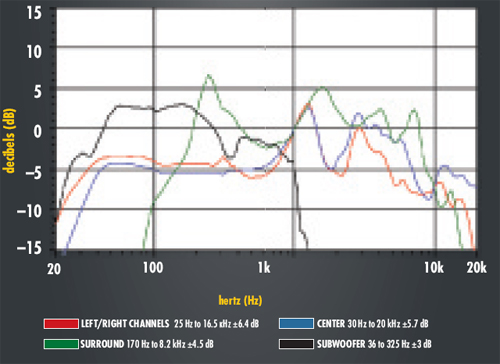Atlantic Technology FS-7.0 Soundbar and SB-800 Subwoofer Page 3

TEST BENCH
Frequency response (at 2 meters)
Left/right channel 25 Hz to 16.5 kHz ±6.4 dB
Center channel 30 Hz to 20 kHz ±5.7 dB
Surround channels 170 Hz to 8.2 kHz ±4.5 dB
Subwoofer 36 to 325 Hz ±3 dB
Sensitivity (SPL at 1 meter with 2.8 volts of pink-noise input)
Left/right channels 77 dB
Center channel 82 dB
Surround channels 81 dB
Impedance (minimum/nominal)
Left/right channels 15.6/17
Center channel 5.3/12
Surround channels 4.3/5
The frequency-response curve in the graph is weighted to reflect how sound arrives at a listener's ears in a typical room and mounting configuration-with adjustments made to accommodate the FS-7.0's unusual configuration. All measurements were made at 2 meters. For measurements from the left and center channels, the FS-7.0 was placed on a 6-foot stand, which gives quasi-anechoic results to about 200 Hz including cabinet diffraction and front-panel reflections. The surround channels, which employ drivers that fire to the side/rear, was measured from a right angle to the speaker, and weighted as if it were a left/right speaker. (Our ordinary surround speaker weighting, with double-weighting on measurements taken at 60° off-axis, doesn't seem to apply to the FS-7.0's reflecting surround channels.) In all cases, response of the front woofers was close-miked and spliced to the appropriate quasi-anechoic responses. Response of the SB-800 subwoofer was measured by close-miking the woofer and port, then summing their responses.
As you can see in the graph, the frequency response of the left and center channels matches pretty well. Neither one is particularly even, but given that part of their sound is piped into the side-firing surround speakers, there's no way they could be. The left channel exhibits a big +7 dB peak at 1.3 kHz and a +5 dB peak at 2.9 kHz; the center channel shows a similar response. Surprisingly, the off-axis response for the left channel is quite consistent, barely varying at all until the mike was moved 45º off-axis. The off-axis response of the center channel, though, shows the "random hash" that indicates considerable interference between drivers. Fortunately, it all averages out to deliver a response that's a little flatter than what I measured from the left channel.
Frequency response measurements for the left side and left rear surround channels were essentially identical, which is not surprising given that they use different voice coils of the same driver. However, the phase of the rear surround channel relative to the side surround channel shifts above 300 Hz; by 20 kHz, the output is about 300 degrees out of phase. This suggests that the rear surround channel inputs are fed into all-pass filters, which shift the phase but do not affect frequency response. I assume the intent is to give the rear surround channel a more spacious sound relative to the side surround channel, but in listening tests with pink noise I couldn't hear a significant difference in the sound when alternating between the side surround inputs and the rear surround inputs.
The impedance and sensitivity measurements are where things get weird. The surround channels have a somewhat low but not uncommon nominal impedance of 5 ohms. But the left and center channels have nominal impedances of 17 and 12 ohms, respectively - the highest I have encountered since I began measuring speakers in 1997. This means the left, center, and right channels present easy loads to an amplifier, but their impedance is so high that they're not able to pull as much power from an amp as a typical speaker can. This is almost certainly related to the FS-7.0's low sensitivity measurements, which run 5 to 10 dB below average. So your receiver's going to need decent power to drive the FS-7.0; I'd suggest at least 100 watts per channel.
The SB-800 is a typical 8-inch subwoofer, with good output in the midbass but not much in the bottom octave. Maximum output is 102 dB at 63 Hz, and there's usable output even at 25 Hz. Average output from 25 to 63 Hz is 96 dB. The frequency response curve shown in the graph is with the sub's internal low-pass filter deactivated. Combined low-pass function of the driver and the electronic crossover is about -16 dB/octave.
- Brent Butterworth













































